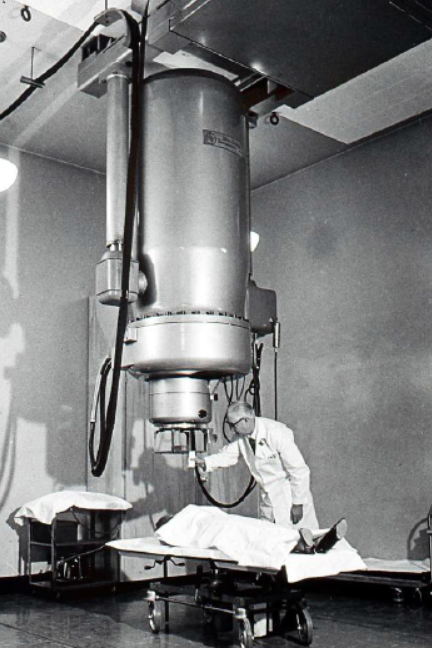Department History

In January 1967, the Department of Radiation Therapy was established at the University of Oregon Medical School. It has the distinction of being the first independent radiation oncology department at a medical school in the United States with Clifford Allen, M.D. as the first Department Chairman. The department offices continued to be located partly within the diagnostic radiology department and partly in the basement of the old Multnomah County Hospital until January 1972 when the department moved to its current location in the South Hospital, fourth floor.
The department treatment equipment prior to 1959 consisted of “deep-therapy” orthovoltage machines at the Medical School Hospital and also at the Portland VA Hospital. Dr. Allen was influential in starting the use of high-dose preoperative irradiation for rectal cancer in 1959, many years before other departments around North America adopted it. The Donner Family Foundation donated a 2-Mev van deGraff accelerator, which was installed in the new medical school hospital (South Hospital) in 1959. A Cobalt-60 treatment machine was added to the department in 1968 and was located in the basement of the outpatient clinic building (where nuclear medicine is currently located).
The treatment machines in that location in 1972 consisted of the 2-Mev van deGraff accelerator, the cobalt-60 machine, and a new 24-Mev Allis Chalmers Betatron, as well as the orthovoltage machine. A treatment planning simulator was added in 1975. In 1981, a 6-Mev linear accelerator replaced the van deGraff generator. Shortly thereafter, the Betatron was replaced with a dual energy 18-Mev linear accelerator. During the late 1970s and early 1980s, hyperthermia was used in the department.
In the 1980s the department name was changed to the Department of Radiation Oncology, previously it was known as the Department of Radiation Therapy. In latter half of 2006, the official name was changed to the Department of Radiation Medicine. There have been four department chairs since the Department was formed, including: Clifford Allen, M.D. (Chair, 1967 to September 1972), William Moss, M.D. (Chair, July 1974 to July 1989), Kenneth Stevens, Jr., M.D., (Interim Chair September 1972 to June 1974, Interim Chair from August 1989 to October 1992, and Chair from November 1992 to July 2005), Carol Marquez, M.D. (Interim Chair, August 2005 to November 2005), Charles R. Thomas, Jr., M.D. (Chair, November 2005 to June 2021) and our current Interim Chair, Arthur Hung, M.D.
Dr. William T. Moss was considered one of the pioneers within radiation oncology, having been awarded the ASTRO Gold Medal in 1981, the American Radium Society’s Gold Medal along with the honor of delivering the 5th Annual del Regato American College of Radiology Gold Medal in 1990, & the St. Georges’ Medal of the American Cancer Society in 1993. He also was the ASTRO President and Board Chair in the mid-1970.
In 2006, Dr. Moss was inducted into the inaugural class of Fellows of the American Society of Therapeutic Radiology and Oncology. Dr. Moss also continued as writer and editor of further editions of his classic text Radiation Oncology: Rationale, Techniques, and Results (currently in its 8th edition), while at OHSU.
The Radiation Oncology Program began as X-ray Therapy in the Multnomah County Hospital at the University of Oregon Medical School in the 1930’s within the Department of Radiology. From the late 1930s to the early 1950s, Dr. Milton and Dr. Selma Hyman were the physicians providing the direction of radiation therapy. With the expansion of the outpatient and ancillary services on Marquam Hill, the University of Oregon Medical School Teaching Hospital opened around the middle of the 20th century. Dr. Kurt R. Straube completed residency training in 1960 and practiced in the program for a few years between the era of the Hymans and Dr. Clifford Allen. Dr. Allen was in charge of the radiation therapy from the mid-1950s until his retirement in 1970.
There had been training of residents in General Radiology (training for two years in diagnostic radiology and one year in radiation therapy) for many years. The first resident receiving training in only radiation therapy started his 3-year residency in 1964. Since 1967 there has been at least one resident per year in straight radiation therapy training.